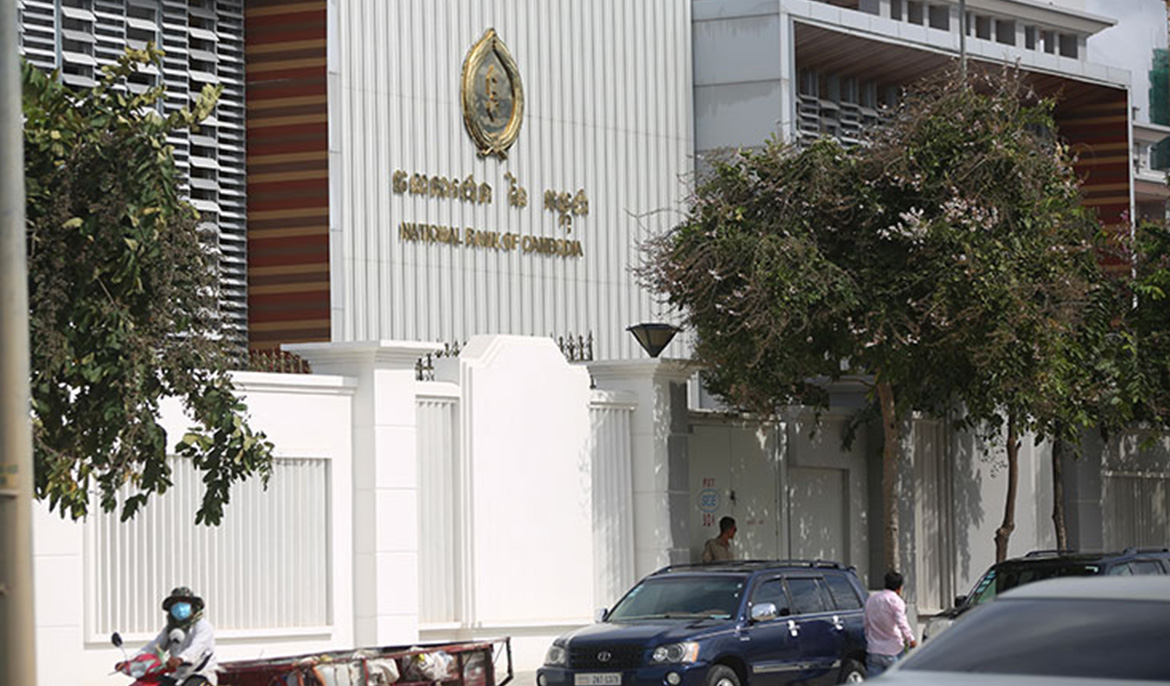In the face of a persistent decline in
the global economic scenario from 3.5 percent in 2022 and for advanced economies 2.6 percent in 2022 to 1.5 percent in 2023, Cambodia’s economy grew by 5.5 percent in 2023 as against 5.2 percent in 2022 and inflation declined to 2.1 percent compared to 5.4 percent over the same period. The story of optimism doesn’t end here. The Kingdom’s economy is projected to grow further by 6.4 percent in 2024. Khmer Times looks at what it takes to become a bright spot in otherwise a gloomy world
Braving global headwinds, Cambodia’s economy grew by 5.5 percent in 2023 as against 5.2 percent in 2022 and inflation declined to 2.1 percent compared to 5.4 percent over the same period. The economy is also predicted to grow by 6.4 percent in 2024.
The Kingdom’s economy achieved this remarkable feat last year even as the ASEAN economic growth went down to 4.4 percent and the global economic growth to three percent, according to the Annual Report 2023 and Action Plan 2024 of the National Bank of Cambodia (NBC), released recently.
The Cambodian central bank’s report revealed that global economic growth declined from the level of 3.5 percent in 2022 and for advanced economies, it was from 2.6 percent in 2022 to 1.5 percent in 2023. In the case of emerging economies, the growth was four percent in 2023 as against 4.1 percent in 2022.
The global economic challenges in 2023, listed by NBC, included the prolonged Russia-Ukraine war that has affected oil prices, supply chain and international trade, the Israel-Hamas war, monetary policy tightening with hikes in benchmark interest rates, capital outflows from emerging countries, the decline of Chinese economic growth with real estate crisis and weak investments and consumptions.
In controlling inflation too, Cambodia’s performance was impressive last year. Compared to the drastic reduction of inflation in the Kingdom in 2023, global inflation remained high at six percent though it declined from the unparalleled height of 8.3 percent in 2022. In ASEAN, inflation was recorded at 8.2 percent last year, up from 7.9 percent in 2022.
Among the segments, industry grew by 6.7 percent in Cambodia in 2023, compared to the previous year. Services expanded by 6.2 percent and agriculture by 1.1 percent.
For 2024, the industry segment is expected to grow by 8.6 percent in the Kingdom, while services by 6.4 percent and agriculture by 1.3 percent. The external challenges for this year, according to NBC, include partner countries having slower growth than expected, continued tightening of monetary policy, tension from global geopolitics, divided global geo-economies and climate changes.
Internal challenges for the Cambodian economy include high indebtedness in private sector, increase in NPLs, weak recoveries from the construction sector, a decline in real estate demand and low arrivals of tourist flights.
Structural challenges for the economy include slow economic diversification and export growth, limited skillsets and productivity of the workforce, high cost of transportation and energy cost, climate change affecting agriculture and high dollarization.
According to the NBC report, tourism and manufacturing sectors mainly drove Cambodia’s growth last year while construction and real estate and agriculture suffered from lower growth.
Despite falling global demand, Cambodia’s garment sector expanded by 1.2 percent, non-garment sector by 0.8 percent, trade, real estate and financial by 0.9 percent, hotels & restaurants by 0.4 percent, agriculture by 0.2 percent and construction by 0.1 percent.
While garment manufacturing increased to $7.6 billion in 2023 from $7.5 billion in 2022, non-garment manufacturing increased to $8.4 billion in 2023 from $8.3 billion in 2022.
Food, drinks and cigarettes sector grew by 22.8 percent in 2023, compared to the previous year and metal by 1.5 times in 2023 but agriculture continued to increase slowly. Paddy/rice was up 3.1 percent in 2023, fisheries, 2.3 percent and rubber, 0.4 percent in 2023.
Tourism made rapid progress in the Kingdom last year, but still remained lower than the pre-Covid-19 level and tourist flight arrivals remained low. International tourists increased to 5.5 million, compared to 2.3 million in 2022 and the growth was driven by tourist arrivals from Thailand, Vietnam, China, Laos and Indonesia.
Local tourist footfall increased to 18.7 million, compared to 13.9 million in 2022 with leading destinations being coastal areas, Phnom Penh and Siem Reap.
The construction and real estate sector, however, registered low growth in the Kingdom last year. The sector was supported mainly by public infrastructure developments.
The country attracted investment worth $6 billion in 2023 from $3 billion in 2022. International reserves increased to $20 billion by the end of 2023, rising from $17.8 billion in 2022. The reserves could cover imports for seven months.
Cambodia’s House Price Index declined by 2.4 percent for November 2023. While the index went down by 3.2 percent for Phnom Penh, for provinces it went up by 3.2 percent.
Meanwhile, according to the trade data released by the General Department of Customs and Excise (GDCE) earlier this month, Cambodia’s international trade stood at $46.82 billion in 2023, recording a decline of 1.9 percent compared to 2022. While exports were marginally up by 1.8 percent, the imports showed a decline of five percent.
The Kingdom’s total exports in 2023 stood at $22.64 billion while the imports were estimated at $24.18 billion. The country recorded a trade deficit of $1.53 billion last year, GDCE data showed.
Banking system
According to the NBC report, many central banks across the world increased the benchmark interest rate to manage inflation last year. While the US pegged the rate by 5.5 percent, it was 3.75 percent for Cambodia. For the EU, it was 4.5, the UK 2.5, China 3.45 and Thailand 2.5.
Deposits in foreign currencies in the country were estimated at 83.4 percent and Cambodian riel (KHR) at 8.9 percent with a money circulation of 7.7 percent. The NBC report noted that KHR is under depreciation pressure due to a decline in the net inflow of USD and an increase in public expenditures. Intervention (mainly in September and October 2023) in the exchange market and implementation of other policy instruments reduced such pressure.
NBC introduced NCD in KHR to absorb KHR liquidity in the market and reduced liquidity-provided collateralised operation (LPCO) in KHR supply from May 2023 to reduce pressure on the exchange rate.
Apart from this, the Reserve Requirement for USD was reduced from nine percent to seven percent with a liquidity release of $1.1B (from $5 billion to $3.9 billion) based on data in December 2023.
According to the NBC report, the banking system continued to grow in Cambodia in 2023 with assets of financial institutions increasing by 8.6 percent to $84.3 billion from $77.5 billion (to KHR 346.7 trillion from KHR 319.2 trillion in 2022.)
Loans increased by 4.8 percent to $57.6 billion (KHR 237.2 trillion) from $55 billion in 2022 (KHR 226.3 trillion.) Deposits grew by 13.1 percent to $47.9 billion from $42.4 billion in 2022 (KHR 197.2 trillion from KHR 174.4 trillion in 2022.)
Non-Performing Loans (NPLs) increased to 5.4 percent for banks from 3.1 percent in 2022 and 6.7 percent for MFIs from 2.5 percent during the same period. Profits generated by banks and financial institutions declined but still remained at an acceptable level for 2023, the NBC report noted.
Liquidity for financial institutions remained high with Liquidity Coverage Ratio (LCR) of 168 percent for banks and 333 percent for MDIs. The Capital Adequacy Ratio (CAR) for banks was 22.7 percent and for MFIs, 25.4 percent.
Of the total loans of $51.8 billion, retail trade loan was the most at 17.6 percent, an increase of 22.3 percent from 2022. Wholesale trade loan constituted nine percent, up 4.8 percent compared to 2022 and manufacturing loan, 4.4 percent, up 17.6 percent, compared to 2022.
Home loans amounted to 13.5 percent, up 6.4 percent, personal loans 9.8 percent, up 28 percent and real estate loans 9.8 percent, up 16.9 percent, compared to 2022. Construction sector consumed 9.5 percent, hotel & restaurant four percent and agri, forestry & fisheries nine percent.
Loan interest rate decreased marginally for banks. Loans in KHR were given at an average rate of 13.4% (13.5 percent in 2022), while loans in USD at 11.1 percent (11.2 percent in 2022).
Deposit rate, meanwhile, increased for banks. Deposits in KHR attracted 7.7 percent interest (6.9 percent in 2022). Deposits in USD attracted 6.5 percent (5.4 percent in 2022.)
Total loans given by MFIs in 2023 declined by 42.6 percent to $5.4 billion (KHR 22.4 trillion), compared to the previous year, due to Prasac’s upgrading to banks. Of this, family loans constituted 30.8 percent, agriculture loans 22.2 percent, business & trade loans 20.3 percent, construction loans 7.1 percent, transportation 2.9 percent and manufacturing 2.9 percent.
According to Chinese news agency Xinhua, Mey Kalyan, advisor to the Cambodian government and chairman of the Cambodia Development Resource Institute, said recently that the government is proactively taking drastic measures to improve the business environment, upgrade infrastructure and logistics, and develop human resources in particular practical skills.
He reportedly said that these measures would accelerate economic growth this year, while at the same time ensuring economic resilience, sustainability, inclusivity and competitiveness.
According to him, Cambodia would continue to draw benefits from the Regional Comprehensive Economic Partnership (RCEP) and the Cambodia-China Free Trade Agreement (CCFTA), which will in turn help boost economic growth.
While addressing an annual meeting of NBC on Thursday, Chea Serey, Governor of the National Bank of Cambodia, said that the Cambodian banking system continues to be strong and that it has played an active role in promoting economic activity and maintaining financial stability in the country.
The global economy faces many challenges disrupting global economic recovery, especially geopolitical tensions, including the prolonged Russia-Ukraine war, the outbreak of war between Israel and Hamas in the Middle East and global warming, she noted.
She added that Cambodia is very proud that its banking system continues to be stable in this situation while some countries experienced a collapse of banking institutions, causing great concern for global financial stability.
Meanwhile, the key priorities for NBC in 2024 include enhancing the implementation of monetary policy by developing instruments and markets to improve KHR usage and establish benchmark interest rate for NBC, manage prudently the reserve requirements, modernise payment services system to support economic growth and globalisation.
It would continue to support financial stability and banking system for key economic sectors, improve the effectiveness of banking services of NBC at headquarters and branches, enhance good corporate governance and risk management, increase the education programme at the Banking Centre from diploma to bachelor, master or equivalent degree, enhance and enlarge data base to align with national economic growth and increase financial inclusion, knowledge in economy and finance at a larger scale.
Meanwhile, the ASEAN+3 Macroeconomic Research Office (AMRO) recently forecast a 6.2 percent growth for the Cambodian economy for 2024 in its January Quarterly Update.
The Kingdom’s projected growth rate is the second highest in the region, trailing by a very low margin behind the Philippines, which is expected to clock 6.3 percent growth in the current year.
At 3.1 percent, Cambodia’s inflation is also set to remain within stable limits in 2024, according to the leading economic research and analysis organisation.
It highlighted the tourism resurgence in the Kingdom though the numbers still haven’t reached the pre-pandemic levels. “As of Q3 2023, service exports across most ASEAN+3 economies (in balance-of-payment terms) have already exceeded end-2019 values, except for a few economies such as Thailand and Cambodia—at around 65 percent—given their large reliance on tourism sector,” the report said.


